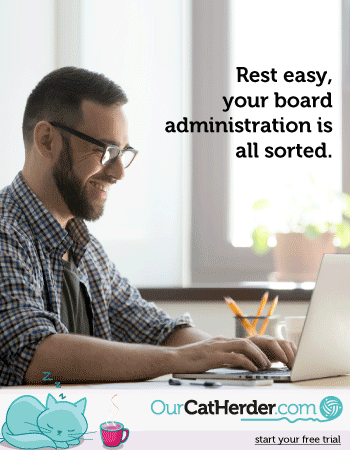governance
It Takes Two To Tango
Published: June 23, 2024
Read Time: 6 minutes

The role of an NFP director continues to become more complex in an increasingly challenging environment. Half of directors who responded to a recent survey1 stated they are spending more time on their director role compared to the previous year.
One way to keep this in check is to focus on improving how information flows between your organisation and your board, and vice-versa. A fundamental mechanism for information flow is the reports presented to your board from the CEO and management. Board reports enable the CEO and management to provide information to the board, and the board to use that information to make informed decisions. Improving the effectiveness of your board reporting can significantly contribute to reducing the burden on directors by streamlining the information flow, enhancing decision-making efficiency, and ensuring board meetings focus on strategic discussions rather than information digestion.
But whose responsibility is it to ensure board reporting is effective? I suggest it is both. Directors and officers have duties to act with reasonable care and diligence.2 This creates somewhat of a symbiotic relationship between directors and the CEO and their management team, with the board seeking information and management providing it.
Directors’ duties – staying informed
Directors have an increasingly complex role and several fundamental duties they must fulfil. One such duty is to act with reasonable care and diligence which includes “a core, irreducible requirement of directors to be involved in the management of the company and to take all reasonable steps to be in a position to guide and monitor. There is a responsibility to read, understand and focus upon the contents of those reports which the law imposes a responsibility upon each director to approve or adopt.3”
If information is not communicated to the board, or the board fails to appreciate the significance of the information, Professor Pamela Hanrahan notes4 that is a failure by the board. That is because the board has the authority, and obligation, to control the information it receives. The Royal Commission Into Misconduct in the Banking, Superannuation and Financial Services Industry Final Report further emphasised the role the board must play in ensuring it has the right information to discharge its function, which includes using that information to hold management to account.
CEO duties – keeping the board informed
Senior executives who are officers5 of your organisation are also subject to the duty to act with reasonable care and diligence in performing their roles, which extends to keeping the board informed. In ASIC v Lindberg6 Robson J found the former Australian Wheat Board managing director had failed to meet his duty to act with reasonable care and diligence by failing to inform the board of matters that clearly should have been brought to its attention.
Further, section 1309 of the Corporations Act (Cth), which applies to all companies limited by guarantee, including registered charities, requires officers and employees to not provide false or misleading information to directors.
The key to maintaining an effective information flow
The duty to act with reasonable care and diligence is objective, and the higher the director’s office (and hence the required degree of skill and/or responsibility), the higher the standard to which they will be held. As such, Chairs play an important role in facilitating the information flow to the board, and a strong Chair/CEO relationship is a non-negotiable element of effective board reporting7. It is vital Chairs are proactively involved in the development of the board agenda and communicating to the CEO what the board is seeking in the papers to support that agenda. This should be an active and ongoing discussion as part of annual board planning, leading up to each board meeting, and through regular board evaluations.
In addition to building and maintaining a productive Chair/CEO relationship, below are three tips for directors who are receiving board reports, and three tips for those who are preparing board reports to contribute towards a more effective information flow:
Tips for Directors
- Ask for what you need: spend some time with your Chair, and then with the CEO and management (either collectively or through the Chair) to set expectations and provide directions on board paper format, structure, content, and timing including the specific types of reports, KPIs and updates needed.
- Be open and engage proactively: ask probing questions and seek additional information as needed. Encourage open and honest communication to create an environment more conducive to management feeling comfortable sharing both positive and negative news.
- Provide feedback: make time on your agenda and in planning and evaluations to regularly assess how effective board reports are for your board and provide that feedback candidly and frequently to the CEO.
Tips for CEO and management
- Establish a reporting template that aligns with what the board has asked for. Templates enable consistency and clarity and ensure none of the key elements of your briefing are missed. A template should at a minimum include:
- what is being asked of the board (decision, discussion, noting etc)
- what is being proposed
- why that option is being recommended (including what other options were considered and the risks for and against each option, including the recommended option)
- how the briefing aligns to the organisation’s purpose or strategy, and
- who else has considered the paper or been consulted along the way.
- Quality over quantity: the Banking Royal Commission Final Report8 emphasised the need for boards to have the right information, not more information. It is the quality, not the quantity, of information that must increase. Often, improving the quality of information given to boards will require giving directors less material, and more information.
- Know your purpose: To help you in achieving quality over quantity, before you write your board report, ask yourself:
- Who is reading this?
- Why are they reading this?
- What is the outcome being sought?
- What information does the reader need to enable the outcome to be achieved?
Keeping up with your duties, and managing the information flow is challenging, but take the time at your next board meeting to ask, ‘Are we receiving the right information?’
This article was first published in the 2024 Better Boards Conference Magazine.
Further Resources
Top Tips For Developing Collaborative Leaders
The Chair-CEO Relationship Roundtable
Board Dynamics: Overcoming Miscommunication Among Directors
-
AICD Not for Profit Governance & Performance Study 2023-24. ↩︎
-
For non-ACNC companies limited by guarantee the duty is established in the Corporations Act 2001 (Cth), s 180(1), and for registered charities, they must take reasonable steps to make sure that their Responsible People carry out the duties set out in ACNC Governance Standard 5, which includes a duty to act with reasonable care and diligence. ↩︎
-
ASIC v Health (2011) FCA 717 (Centro case), at [16] per Middleton J ↩︎
-
Professor Pamela Hanrahan, ‘What Directors Can Learn From the Crown Resorts Inquiry’, 1 April 2021, accessed at What directors can learn from the Crown Resorts inquiry ↩︎
-
which includes anybody who can significantly affect a company’s financial standing, see ASIC v King [2020] HCA No 4 ↩︎
-
[2012] VSC 332. ↩︎
-
AICD Not-For-Profit Governance Principles, Principle 2 also recommends that the Chair be generally responsible for … setting agenda and approving board papers. ↩︎
-
pg. 398 ↩︎
Share this Article
Recommended Reading
Recommended Viewing
Author
-
Founder and Principal Consultant
The Governance Guide
- About
-
The Governance Guide is a governance, policy, and compliance consultancy with a mission to enhance the effectiveness of an organisation’s governance practices, in as simple a manner as possible. Its founder, Rachel Colombi is a Fellow of the Governance Institute of Australia and a Graduate of the Australian Institute of Company Directors.
Rachel’s experience leading governance, policy and compliance functions in the higher education and not-for-profit sectors coupled with experience delivering both small and large-scale strategic improvements brings a unique perspective to The Governance Guide’s offering.
Found this article useful or informative?
Join 5,000+ not-for-profit & for-purpose directors receiving the latest insights on governance and leadership.
Receive a free e-book on improving your board decisions when you subscribe.
Unsubscribe anytime. We care about your privacy - read our Privacy Policy .










